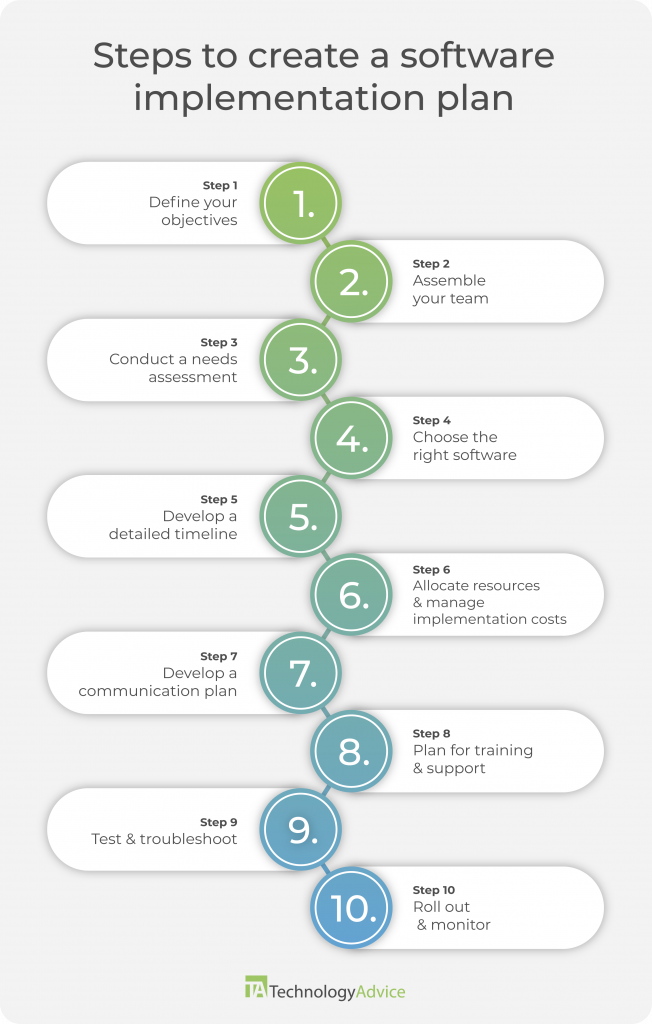


Discover best practices for creating a successful software implementation plan. Get tips on timeline management and communication strategies here.
Staff WriterTechnologyAdvice is able to offer our services for free because some vendors may pay us for web traffic or other sales opportunities. Our mission is to help technology buyers make better purchasing decisions, so we provide you with information for all vendors — even those that don’t pay us.
Last Updated: August 14, 2023 Published Date: May 2, 2023Table of contents



A big software purchase requires big planning. Whether your company will be buying your first ERP, CRM, or HR software, or upgrading from a clunky legacy system that no longer meets your needs, understanding your software implementation timeline can help you plan better.
You may have just purchased software for your business and realized implementation and adoption is more of an undertaking than you initially thought. Or maybe you are considering a major businesses-wide software purchase and are looking ahead to the next step in that process. This software implementation guide is designed to help you minimize disruption in your business and increase your chances of a smooth, successful implementation.
A software implementation plan is a detailed, step-by-step guide that outlines the process of introducing and integrating a new software system into an organization. It covers everything from the initial assessment of the organization’s needs to the final rollout and ongoing support.
The main goal of a software implementation plan is to ensure the new software is successfully adopted and the organization reaps its full benefits.

Begin by defining your software implementation plan’s goals and objectives, ensuring they are specific, measurable, achievable, relevant, and time-bound (SMART). By establishing clear objectives, you can align your project team and stakeholders with a common purpose, which is essential for a successful software implementation.
Identify key stakeholders and assemble a cross-functional implementation team to oversee the software implementation process. This team should include representatives from different departments, such as IT, HR, and operations. Each team member should be clear on their roles and responsibilities.
Analyze your organization’s current systems, processes, and workflows to determine the requirements for the new software. Identify any gaps, inefficiencies, or areas that need improvement. This information will help you select the right software and configure it to meet your organization’s specific needs.
Based on your needs assessment, research and evaluate potential software options. Consider factors such as ease of use, scalability, customization. And integration capabilities. Look for a solution that addresses your organization’s specific needs and requirements, and don’t forget to involve your team in the decision-making process to ensure buy-in and support.
Create a project implementation plan that outlines each phase of the implementation process. Break the project down into smaller tasks and assign deadlines for each. Utilize project management best practices to ensure the timeline is realistic and provides enough time for training, testing, and troubleshooting.
Determine the resources you’ll need for the implementation, including personnel, budget, and equipment. Make sure you have enough resources to support the project throughout its duration and carefully manage implementation costs to avoid budget overruns.
Effective communication is vital for a successful implementation. Develop a communication plan that outlines how you will keep all stakeholders informed about the project’s progress, including regular status updates. Meeting, and progress reports. Ensure communication channels are clear and that all team members know how and when to provide updates or ask for assistance.
Your team will need training and ongoing support to ensure a smooth transition to the new software. Develop a training plan that covers all relevant aspects of the software, tailored to the needs of different user groups. Additionally, establish a support system for addressing questions, troubleshooting issues, and providing ongoing assistance.
Before rolling out the new software, conduct thorough testing to identify and resolve any issues. This may include unit testing, integration testing, and user acceptance testing (UAT). Fix any bugs and make any necessary adjustments so the software performs optimally. User acceptance is a critical milestone that signals the readiness of the new system for organization-wide deployment.
Once testing is complete, roll out the software to the entire organization according to your timeline. Monitor the implementation closely, gather feedback from users, and make any necessary adjustments. Continue to provide ongoing support and regularly evaluate the software’s performance to ensure it meets your organization’s needs.
A well-thought-out software implementation plan minimizes risk by helping you identify potential challenges early in the process. By establishing a clear roadmap, businesses can save time and resources by avoiding costly mistakes. A robust plan also ensures alignment across team members as a shared understanding of the project’s goals and steps can help collaboration efforts and keep all stakeholders informed and engaged throughout the implementation process.